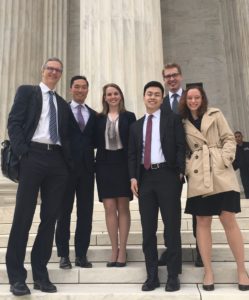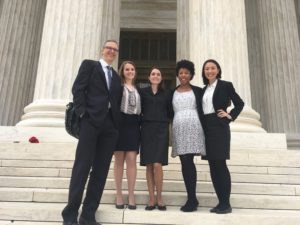Stanford Law Students Describe Journey from Certorari to Oral Argument at Supreme Court
On February 27, 2017, the U.S. Supreme Court heard oral arguments in Esquivel-Quintana v. Sessions, a case handled by the Supreme Court Litigation Clinic. The case involves the question whether consensual sexual intercourse between a 21-year-old and someone almost 18 should be considered an “aggravated felony” and thus constitute grounds for mandatory removal under the Immigration and Nationality Act (INA).
To read more details and analysis of the case, visit SCOTUSblog here. To hear audio recordings of oral arguments in the case, visit Oyez here.
In this blog post, clinic students Zoé Friedland JD (’17), Shannon Grammel (JD ’17), Amari Hammonds (JD ’17), and Adrienne Pon (JD ’18) describe the clinic’s involvement in the case so far.

Pre-Argument Work
The Clinic has been with the case since the cert stage, as has Shannon Grammel (JD ’17). So it’s been really fascinating to watch the case evolve over time. The case seemed very clean initially, but it got all the more complicated as we dug in and the litigation progressed. The day cert was granted we had a small clinic celebration before immediately getting to work researching. The nature of this case entailed a lot of in-the-weeds research, and Zoé Friedland (JD ’17) spent a ton of time digging into state criminal codes. We were unfortunately only able to speak to Juan, our client, once. That was before cert was granted. Hearing from him was truly inspiring and made the case all the more meaningful and important to us.

Moots
[Professor] Jeff Fisher did three moots, and we all attended the moots at SLS and Georgetown. The moots went incredibly well. Adrienne Pon (JD ’18) served on the bench for the SLS moot and asked Jeff some tough questions. It was always fun to watch the “aha moment” when the case clicked for the judges on the panels. After the moots, Jeff would ask for our feedback. We would also ask the panelists how certain arguments and answers went over.
Argument Prep
After the moots and before the arguments, we discussed the tough questions and potential answers with Jeff. It was a lot of fun to brainstorm like this, as we had no idea how much we knew about the case and how prepared we were to be thinking about these issues. Having spent months on the case and all the background materials, we felt well-equipped to help Jeff brainstorm ideas.
Pre-Argument at the Court
It was incredible to visit the Court. Jeff was able to get us into the lawyer’s lounge beforehand for the lawyer’s briefing. It was useful to hear the mechanics of exactly how everything would work. We also had the fortune of being seated directly in front of the client’s family at the argument. They drove through the night from Michigan to have the opportunity to hear the case, which reminded us of the important role our brave clients and their families play even at this stage of the case. That was the first time we had ever met them–in our seats at the Supreme Court, asking the Court to let their son come home.

Argument
Jeff did a phenomenal job, and it was incredibly inspiring and fulfilling to watch all the work we’d done throughout the year come to fruition. The argument started off with a question we’d expected from Justice Kagan. But then things took a turn and the Court spent most of its time on an issue we had not expected to be so prominent. Again, it was fascinating to watch how the case evolved over time at the different stages of litigation. And it was really interesting to see the other side of the case argued for the first time–the moots had only involved the argument on our side.

Post-Argument
We took photos on the steps of the Court and then debriefed over lunch. It was a bittersweet feeling–the argument went well and it was incredible to watch it live, but it’s sad that opportunity to work together is over. We feel so invested in this case and are looking forward to reading the opinion in the next few months.
About the Stanford Supreme Court Litigation Clinic
The Supreme Court Litigation Clinic, which was the first of its kind at any law school, is one of 11 clinics currently offered at Stanford Law School. Students enrolled in a clinic spend a full academic quarter working on real cases with real clients, with no other distractions. In recent years, the clinic has represented clients on issues including federal anti-discrimination laws, the Fair Labor Standards Act, criminal defendants with constitutional claims, public interest and trade associations, the free exercise of religion, bankruptcy law and the Voting Rights Act.
About Stanford Law School
Stanford Law School is one of the nation’s leading institutions for legal scholarship and education. Its alumni are among the most influential decision makers in law, politics, business and high technology. Faculty members argue before the Supreme Court, testify before Congress, produce outstanding legal scholarship and empirical analysis, and contribute regularly to the nation’s press as legal and policy experts. Stanford Law School has established a new model for legal education that provides rigorous interdisciplinary training, hands-on experience, global perspective and focus on public service, spearheading a movement for change.
